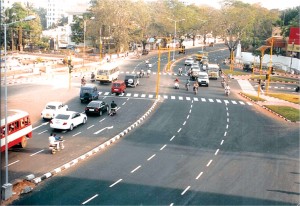Registered with the Registrar of Newspapers for India under R.N.I 53640/91
Vol. XXV No. 13, October 16-31, 2015
Will pedestrians ever get their due?
by A Special Correspondent
Come Navaratri, the four Mada Streets around the Mylapore tank brace themselves for an extra dose of chaos. Makeshift stalls selling the traditional clay dolls take over the footpaths and also a good bit of the road. Buyers come in large numbers, most of them in cars, and clog whatever space is left.
Where do the pedestrians go? The traffic snarls this year have been to such an extent that many neighbouring areas such as Royapettah and Mandaiveli have also felt the impact.
And yet the Administration is most reluctant to make this space a pedestrian zone, at least for the duration of the festival.
This attitude indicates the lack of will to confront the problem and come up with a creative solution to it. At present, the area has been left to manage on its own, and what little traffic movement there is, is thanks to the highly inadequate police force and local good Samaritans. Why is the Chennai administration not able to take a leaf out of the many international cities that it aims to emulate? The world over, new urbanism is in and one of its tenets is the making of cities as pedestrian-friendly as possible. This thinking states that “being able to walk to a mix of shops, restaurants, newsstands and work centres delivers the highest quality of life, and adds great variety and vitality to an area.”

Looking after pedestrians (above) on the improved Kowdiar Road stretch in
Thiruvananthapuram (below).
There is a growing demand for making entire city districts pedestrian. Many urban centres are working towards it and, for a start, many heritage areas in metros are entirely off limits for private cars. That this is not entirely an elitist exercise, ‘not suited to third world countries like ours especially with hot weather’, as the common excuse is, has become evident with the Indian town of Gurgaon, a neighbour of New Delhi and a part of the National Capital Region, experimenting with the concept. Beginning September 22nd this year, the city administration has declared that Tuesdays will be car-free days in certain areas. The initiative, jointly launched by the police, the NGO Embark Rahagiri, and a citizen’s forum, met with poor response on the day of its launch but those behind the move have said they are not giving up in a hurry. They realise, they have declared, that such moves take time and will only bear fruit in the long run. In Chennai too, the Corporation has embarked on such an exercise in the Elliots Beach area every Sunday where it has seen good results.

Mylapore in our city is ideally suited for such an activity. It is well serviced by public transport – plenty of buses ply on RK Mutt Road connecting various parts of the city. In addition there is the MRTS facility, which is a stone’s throw from the temple tank. These days, there are also plenty of call taxi facilities either via phone or through mobile apps. And as the Administration makes the area out of bounds for vehicles on the Arupathumoovar procession day in March/April, it is not an unprecedented suggestion.
One of the key stumbling blocks to such a move has been the attitude of the local shops and establishments. They are of the view that custom and trade will be affected if vehicles are kept off. They also feel that the doll sellers are interlopers and there are instances of many shops trying to prevent the hawkers from setting up their stalls on the footpaths – not out of any altruism but because they block access to the outlets. This is an extremely short-sighted view. Traditionally business has boomed in any area that is declared pedestrian chiefly because of the ease of movement that it brings about.
The Corporation of Chennai has recently begun an exercise of building a wide pedestrian pathway leading all the way from the Luz Church to the tank. This is most welcome but it will do wonders for the area only if the plan is combined with a pedestrian initiative, at least on certain days of the year, for the four Mada Streets.
Road improvement
As the Advisor to the Government of Kerala for the Capital City Road Improvement Project, N.S. Srinivasan evolved a comprehensive road and traffic improvement programme for Thiruvananthapuram city, and rendered technical guidance in implementation and monitoring of the project. The implementation and maintenance for 15 years have been taken up as a Public Private Participation Project. This is the first time such a comprehensive road and traffic improvement programme has been executed in the country. The International Roads Federation, Washington, has chosen the Trivandrum Road Development Project as the best “Urban Planning and Mobility Project” for the year 2015.
Considering the usefulness and success of this project, the Government of Kerala has taken up a similar programme in Kozhikode under PPP (Public Private Partnership) model. It is hoped that such schemes will be taken up in other cities also.
The photographs show the Kowdiar road stretch and intersection.
A Correspondent

